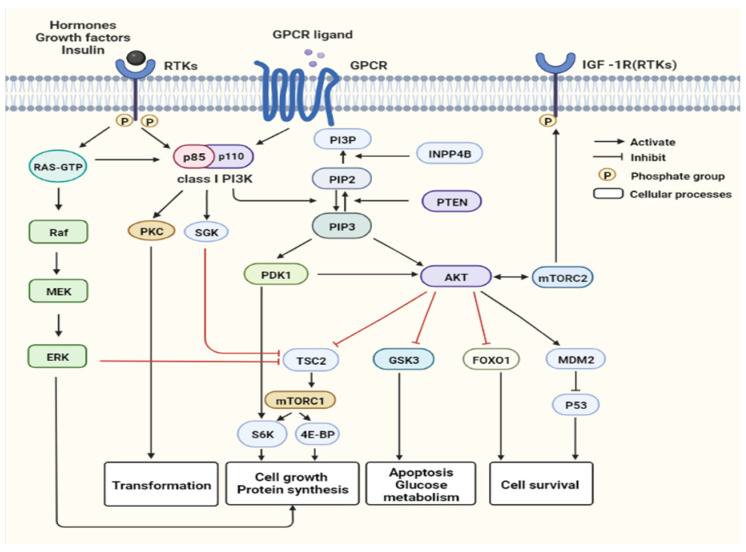Figure 2.
The PAM signaling pathways. PAM pathway can be activated by G protein-coupled receptor (GPCR) and receptor tyrosine kinases (RTKs), including human epidermal growth factor receptor 2 (HER2/ERBB2), fibroblast growth factor receptor (FGFR), insulin and insulin-like growth factor-1 receptor (InsR/IGF-1R), which PtdIns (4,5) P2 (PIP2) to generate the second messenger PtdIns (3,4,5) P3 (PIP3) [6]. PTEN (phosphatase and tensin homolog) dephosphorylates PIP3 to generate PIP2, while INPP4B (inositol polyphosphate-4-phosphatase type II B) dephosphorylates PtdIns(3,4)P2 to generate PtdIns(3)P (PI3P). Proteins, containing a pleckstrin homology (PH) domain, are recruited to the cytomembrane by PIP3, including AKT, 3-phosphoinositide-dependent kinase 1 (PDK1), and serum and glucocorticoid-induced kinase (SGK). The main downstream target of PI3K is AKT. It is activated by PDK1 and mTOR complex 2 (mTORC2), and phosphorylates a large number of downstream effector proteins, including mTOR complex 1 (mTORC1), forkhead box protein O1 (FoxO1), glycogen synthesis kinase (GSK3) and murine double minute 2 (MDM2). The AKT-mediated phosphorylation of GSK3β, FOXO1 and MDM2 directly or indirectly controls cellular growth and survival. The activated mTORC1 ultimately regulates cellular processes, such as the initiation of mRNA transcription, cell growth, autophagy and protein synthesis, via phosphorylation of 4EBP1 and S6K1 [1,7]. In addition, mTORC2 can phosphorylate both IGF-1R and AKT [8]. S6K-mediated phosphorylation of PDK1 negatively feed back to inhibit PDK1 [7]. PKC and SGK are also involved in PI3K signaling independent of AKT.

